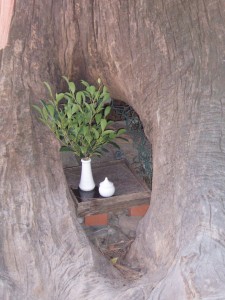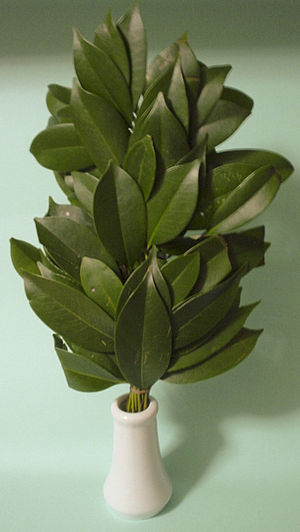
As we approach the mid-winter solstice, it is worth thinking again about Shinto’s sacred tree – sakaki. In a previous posting I put forward a theory regarding the linguistic signficance of sakaki. Now I have settled on a different rationale.
Evergreen trees in the midst of a deciduous forest must have been a striking sign of blessedness to ancient humans. Amidst the falling leaves of autumn, the evergreen stood out vigorous and strong, able to resist the demons of cold and decay. In contrast to the human cycle of birth and death, the evergreen represented the eternal, able to continue even in midwinter.
Every culture had its symbolic evergreen, used for spiritual occasions. Egyptians hnoured Ra with palm branches. Romans placed evergreen in homes for Saturnalia. Celts and Vikings used a variety of evergreen, such as fir, spruce and pine. And of course there is the Christmas tree, a pagan custom taken over by Christians because it was so powerful. The spirit in the tree defies the cycle of winter decay and death.
Green has long been seen as a healing and soothing colour. Immersion in wooded greenery is known to be mentally calming, and the recent fashion for shinrin-yoku (forest bathing) has been shown to have many benefits. Green represents a deep connection to nature.
But here is the question: why did Shinto choose sakaki out of all the other possibilities? Japan after all is a land of wonderful pine trees. Would that not be more suitable?
In all the books on Shinto I have read, I could never find an answer to this question, which is odd since it is so central. I even tried asking priests, but they did not come up with anything satisfactory. But now I see that an answer is easily available on google. Such is the blessing of the age in which we live.
Here is the gospel according to google: “Sakaki began to be used in Shinto rituals because since ancient times people believed that gods sometimes choose to dwell in plants, and what’s more, branches with pointed leaves (like the sakaki branch) are considered yorishiro.”
Yorishiro are objects into which kami descend, so it seems the leaves of the sakaki were attractive to them. In fact, looking back on a previous Green Shinto post I find that I already wrote of this, proving google has a better memory than myself! “Plants with point-tipped leaves, such as pines and thorns, were believed to be the landing point for spirits, and this was no doubt how the association with the sakaki arose. Its evergreen nature, like the Christmas fir tree, must have appealed to ancients as a symbol of nature’s vitality and kami immortality.”

The ‘point-tipped leaves’ make particular sense to me, because I remember discussing magatama once with an eminent archaeologist at my university (he made the national news for discussing the grave of O no Yasumaro, compiler of Kojiki (710)). I asked him about the shape of the magatama jewel, and he said it was a kind of hook for attracting kami, almost as if one were fishing for invisible spirits.
The sakaki tree is found acsross East Asia and as far as India, though it is known botanically as cleyera japonica. I have a theory that much of Shinto came not through the Korean peninsula as is commonly supposed, but from through southern Kyushu from Chinese coastal regions (see here). Recent DNA research lends support to the supposition. In this respect it is interesting to note that the sakaki grows in China too and could well have arrived with the kami who ‘descended’ on Mt Takachiho (my theory would suppose Ninigi no mikoto actually arrived by sea via Kinko Bay).
Wikipedia tells us the sakaki tree can reach a height of 10 m, and that the oval-shaped leaves are 6–10 cm, leathery and shiny. In early summer there are small, scented cream-white flowers, followed by berries which start red and turn black. The wood is used for building and utensils.

A final midwinter thought: how about the lyrics below for a Shinto solstice song? (discerning readers will be able to identify the tune)…
O sakaki, O sakaki,
You bear a joyful message:
That faith and hope shall ever bloom
To bring us light in winter’s gloom.
O sakaki, O sakaki,
You bear a joyful message
********************
Footnote: Shinto scholar Mark Teeuwen has pointed out that there is no ‘hook’ on the sakaki leaves, and that it may be the thick ‘plastic’ nature of the leaves made them stand out from other plants. JD suggested this may well have been a factor, and that the leaves can be easily cleaned of dust and impurities.

Hooray for botanical themed posts! I love it! Thank you.